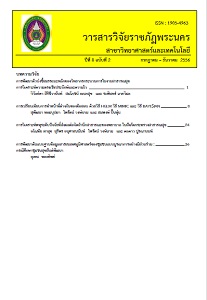การพัฒนาต้นแบบฐานข้อมูลสารสนเทศภูมิศาสตร์ของชุมชนแบบบูรณาการ อย่างมีส่วนร่วม : กรณีศึกษาชุมชนสุขสันต์พัฒนา
คำสำคัญ:
การพัฒนาต้นแบบ, ฐานข้อมูลสารสนเทศภูมิศาสตร์, บูรณาการ, Prototype development, Geographic information database, Integrationบทคัดย่อ
การวิจัยนี้มีวัตถุประสงค์ในการพัฒนาฐานข้อมูลสารสนเทศภูมิศาสตร์ต้นแบบ สำหรับการวางแผน การบริหาร จัดการ และการบริการเชิงพื้นที่ในเขตพื้นที่ชุมชนในประเทศไทย โดยใช้พื้นที่ชุมชนสุขสันต์พัฒนาเป็นพื้นที่ตัวอย่าง การ พัฒนาดังกล่าวเป็นการจำลองสภาพภูมิประเทศตามธรรมชาติและสิ่งอำนวยความสะดวกพื้นฐานที่สร้างขึ้น ให้อยู่ในรูปชั้น ข้อมูลสารสนเทศภูมิศาสตร์ดิจิทัลโดยใช้เทคโนโลยีภูมิสารสนเทศ การพัฒนาฐานข้อมูลสารสนเทศภูมิศาสตร์ได้จัดทำเป็น ขั้นตอนจาก 1) สำรวจความต้องการของชุมชน 2) ทำการออกแบบเชิงแนวคิดและเชิงตรรกะเพื่อสร้างพจนานุกรมข้อมูล 3) แปลความหมายข้อมูลดาวเทียมรายละเอียดสูง 4) สำรวจและตรวจสอบข้อมูลภาคสนาม 5) จัดทำฐานข้อมูลสารสนเทศ ภูมิศาสตร์ให้เป็นไปตามพจนานุกรมข้อมูล 6) จัดทำแผนที่ 7) ตรวจสอบความถูกต้องและทดลองเรียกใช้งาน และ 8) เผยแพร่ข้อมูลสารสนเทศภูมิศาสตร์ ฐานข้อมูลสารสนเทศภูมิศาสตร์ดิจิทัลมี 17 ชั้นข้อมูลเชิงพื้นที่ 17 ตารางข้อมูลจริง ได้รับการออกแบบโครงสร้างให้ เป็นฐานข้อมูลเชิงสัมพันธ์ แต่ละชั้นข้อมูลมีองค์ประกอบในรูปจุดหรือเส้นหรือพื้นที่รูปปิด ที่มีระบบพิกัด UTM Zone 47 กำกับ ทุกองค์ประกอบเชื่อมต่อกับข้อมูลเชิงอรรถ เพื่อบ่งบอกถึงคุณลักษณะ ได้ทำการประชุมเพื่อนำเสนอข้อมูลสู่ชุมชน การตรวจสอบและทดลองใช้งานฐานข้อมูล ผลปรากฏว่าสามารถเรียกดู ระบุ สืบค้น ค้นคืนและวิเคราะห์ข้อมูลจากฐานได้ อย่างมีปฏิสัมพันธ์กับผู้ใช้
THE DEVELOPMENT OF THE PROTOTYPE OF GEOGRAPHIC INFORMATION DATABASE FOR COMMUNAL BY INTEGRATION AND COMMUNITY PARTICIPATION APPROACH: A CASE STUDY OF SOOKSAN PATTANA VILLAGE
The research project aims to develop the prototype of a geographic information database towards villages in Thailand in order to plan, manage and service to communities in Thailand. The Sooksan Pattana Village is selected as a study area. The development is to model the natural topography and built-up infrastructures in the villages to be in forms of digital data layers using geoinformatics technology. The research process consists of 8 steps. The first involves user requirement survey, former data and information collection and examination. The second relates conceptual and logical database designs to achieve data dictionary. The third works on high-resolution remotely sensed data interpretation. The fourth deals with ground check survey. The fifth copes with geographic information database construction following the data dictionary. The sixth is mapping process. The seventh involves in database examination and correction. The last is to publish geographic information data.
The relation database constructed consists of 17 spatial data layers, 17 actual data tables. Each data layer represents spatial features in either point or line or polygon with Zone-47 UTM coordination system. Each spatial record is linked to non-spatial data to specify its attributes. Meeting with community readers is arranged in order to check and test the database. It is shown that the development of geographic information database can be effectively interacted with users in terms of search, identification, search, query, and analysis.
ดาวน์โหลด
ฉบับ
ประเภทบทความ
สัญญาอนุญาต
โปรดกรอกเอกสารและลงนาม "หนังสือรับรองให้ตีพิมพ์บทความในวารสารวิจัยมหาวิทยาลัยราชภัฏพระนคร สาขาวิทยาศาสตร์และเทคโนโลยี" ก่อนการตีพิมพ์




